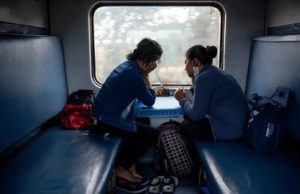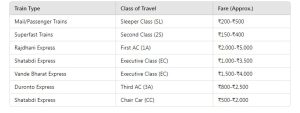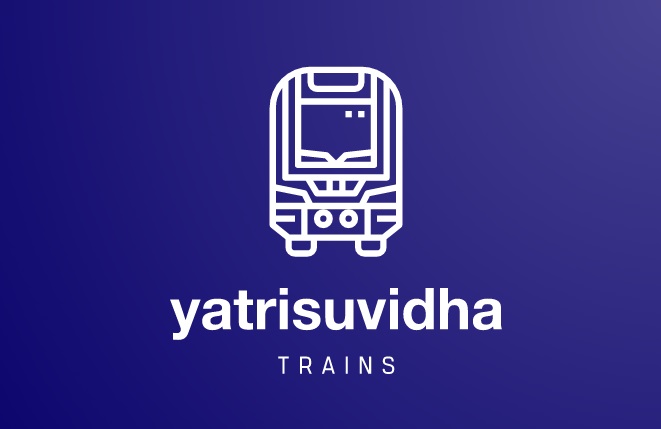
Train Fares in India: Types, Pricing, and Factors Influencing Costs
India’s extensive railway network is one of the largest and most significant in the world, catering to millions of passengers daily. Indian Railways offers a wide array of travel options, ranging from budget-friendly trains to more luxurious services, all with varying fare structures. Understanding train fares in India can help travelers plan their journeys more efficiently and budget accordingly. This article provides a comprehensive overview of train fares in India, covering the types of tickets, fare calculation, and various factors that influence train ticket prices.
- Types of Train Services in India
Before diving into the details of train fares, it’s important to understand the different types of train services available in India. Indian Railways categorizes its trains based on speed, services, and classes of travel. The primary types of trains are:
1.1. Express Trains
Express trains are one of the most common categories of trains in India. They cover long distances at a faster speed compared to slower trains, but they stop at more stations than super-fast trains.
1.2. Superfast Trains
Superfast trains are high-speed services that cover long distances quickly. These trains stop at fewer stations and offer faster travel times.
1.3. Rajdhani Express
Rajdhani Express trains are premium services that connect major cities like Delhi to other important cities across India. They are known for their speed, luxury, and high-level services. Rajdhani fares are typically higher than those of regular express trains due to the added amenities.
1.4. Shatabdi Express
The Shatabdi Express is another premium train service, providing fast and comfortable travel between major cities, typically with shorter distances compared to Rajdhani. The train offers excellent onboard services such as meals and high comfort, with fares higher than those of regular express trains but lower than Rajdhani.
1.5. Vande Bharat Express
The Vande Bharat Express is a modern, semi-high-speed train service that boasts world-class amenities and comfort, aimed at providing faster, more efficient travel. The ticket prices for Vande Bharat are relatively higher due to its advanced features.
1.6. Mail/Passenger Trains
Mail and passenger trains are slower services that stop at almost every station on their routes. These trains are often the most affordable options, with the lowest ticket prices.
- Types of Ticket Classes in India
Train fares in India are heavily influenced by the class of travel. There are several classes to choose from, each offering different levels of comfort, privacy, and services. These are categorized based on the type of coach.
2.1. Sleeper Class (SL)
Sleeper Class is the most affordable class on Indian trains, offering basic amenities. The seats are not air-conditioned and are shared with multiple passengers in an open arrangement. This is the most budget-friendly option and is popular for short and long-distance travel.
2.2. Second Class (2S)
Second Class is a non-air-conditioned class, usually found in suburban trains and some long-distance trains. It provides basic seating but no berths for sleeping. The fares are slightly higher than those of the sleeper class but still very affordable.
2.3. Third AC (3A)
Third AC (3A) coaches are air-conditioned coaches with three-tier sleeping arrangements. They are moderately priced and offer a higher level of comfort than Sleeper Class. This is a popular choice for budget-conscious travelers who need more comfort.
2.4. Second AC (2A)
Second AC (2A) offers more luxurious seating and sleeping arrangements than Third AC. It has two tiers of berths, and the coaches are air-conditioned, providing a more comfortable and quieter journey. This class is priced higher than Third AC and is often chosen for longer journeys.
2.5. First AC (1A)
First AC (1A) offers the highest level of luxury, with spacious compartments, private cabins, and excellent services. The coaches are air-conditioned, and passengers enjoy a high degree of privacy and comfort. This is the most expensive class of travel on Indian trains.
2.6. Executive Class (EC)
Executive Class is available primarily on Shatabdi and Vande Bharat Express trains. It provides a high level of comfort with plush seats and air-conditioning, making it an ideal choice for business travelers. The fares are typically higher than Second AC but lower than First AC.
2.7. Chair Car (CC)
Chair Car is a seating-only class typically available on shorter routes and trains like the Shatabdi. The coaches are air-conditioned, and passengers are provided with comfortable seating. The fare for Chair Car is usually higher than Second Class but lower than the other AC classes.
- Factors Affecting Train Fares in India
Several factors play a role in determining the fare for a particular train journey in India. These factors are often dynamic, meaning prices can vary based on the season, availability, and booking time.
3.1. Train Type
As mentioned earlier, the type of train—whether it’s a regular express, superfast, or premium service—significantly affects the ticket price. Premium services such as the Rajdhani, Shatabdi, and Vande Bharat Express charge higher fares due to the superior services, quicker travel times, and higher operational costs.
3.2. Class of Travel
The class of travel is perhaps the most significant factor affecting train fares. First AC and Executive Class tickets are the most expensive, while Sleeper and Second Class tickets are much cheaper. Higher classes of travel offer greater comfort, air-conditioning, and privacy, all of which come at a higher price.
3.3. Distance
The longer the distance traveled, the higher the fare will be. However, train fares are generally more affordable for long distances than other modes of transport like flights, especially in sleeper and third AC classes.
3.4. Time of Booking
Booking a train ticket early can result in a lower fare, especially for Tatkal tickets (which are typically more expensive). Train fares are dynamic and can increase as the date of travel approaches, especially if the demand is high.
3.5. Seasonal Factors
Train fares can also fluctuate based on the time of year. During peak travel seasons like festivals or summer holidays, fares tend to rise due to increased demand. Conversely, during off-peak seasons, ticket prices can be lower.
3.6. Dynamic Pricing (Flexi-fare)
For some premium trains like Rajdhani, Shatabdi, and Duronto, Indian Railways implements a dynamic pricing system. This means that ticket prices can fluctuate based on factors like the demand and how close the booking date is to the date of travel. The closer to the date, the higher the price can be.
3.7. Concessions and Discounts
Indian Railways offers various concessions for specific groups such as senior citizens, students, and persons with disabilities. These discounts can lower the overall fare, making train travel more affordable for certain travelers.
- Examples of Train Fares
To give you a clearer picture, here are some examples of train fares based on different classes of travel and train types:

Train Type Class of Travel Fare (Approx.)
Mail/Passenger Trains Sleeper Class (SL) ₹200-₹500
Superfast Trains Second Class (2S) ₹150-₹400
Rajdhani Express First AC (1A) ₹2,000-₹5,000
Shatabdi Express Executive Class (EC) ₹1,000-₹3,500
Vande Bharat Express Executive Class (EC) ₹1,500-₹4,000
Duronto Express Third AC (3A) ₹800-₹2,500
Shatabdi Express Chair Car (CC) ₹500-₹2,000
(Note: These are approximate fares and may vary based on distance, season, and availability.)
Train travel in India is an affordable and convenient way to cover long distances across the country. The fare structure is designed to cater to a broad spectrum of travelers, from budget-conscious passengers to those seeking luxury and comfort. Factors like train type, class of travel, distance, time of booking, and seasonality can all affect ticket prices. Understanding these elements allows travelers to make informed choices about their journeys, balancing comfort and affordability according to their needs.
Whether you’re taking a short trip or embarking on a cross-country adventure, Indian Railways offers a range of options to suit every budget and preference.

Leave a Reply